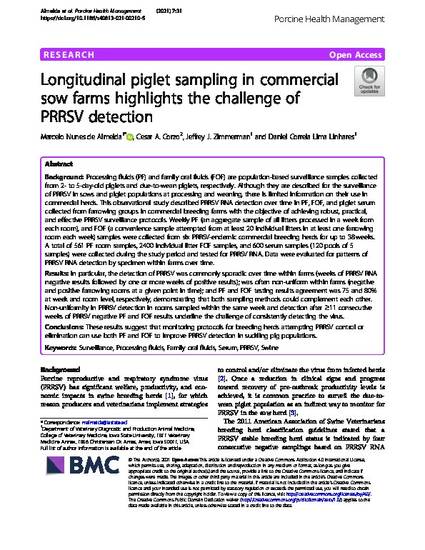
Background: Processing fluids (PF) and family oral fluids (FOF) are population-based surveillance samples collected from 2- to 5-day-old piglets and due-to-wean piglets, respectively. Although they are described for the surveillance of PRRSV in sows and piglet populations at processing and weaning, there is limited information on their use in commercial herds. This observational study described PRRSV RNA detection over time in PF, FOF, and piglet serum collected from farrowing groups in commercial breeding farms with the objective of achieving robust, practical, and effective PRRSV surveillance protocols. Weekly PF (an aggregate sample of all litters processed in a week from each room), and FOF (a convenience sample attempted from at least 20 individual litters in at least one farrowing room each week) samples were collected from six PRRSV-endemic commercial breeding herds for up to 38 weeks. A total of 561 PF room samples, 2400 individual litter FOF samples, and 600 serum samples (120 pools of 5 samples) were collected during the study period and tested for PRRSV RNA. Data were evaluated for patterns of PRRSV RNA detection by specimen within farms over time.
Results: In particular, the detection of PRRSV was commonly sporadic over time within farms (weeks of PRRSV RNA negative results followed by one or more weeks of positive results); was often non-uniform within farms (negative and positive farrowing rooms at a given point in time); and PF and FOF testing results agreement was 75 and 80% at week and room level, respectively, demonstrating that both sampling methods could complement each other. Non-uniformity in PRRSV detection in rooms sampled within the same week and detection after ≥11 consecutive weeks of PRRSV negative PF and FOF results underline the challenge of consistently detecting the virus.
Conclusions: These results suggest that monitoring protocols for breeding herds attempting PRRSV control or elimination can use both PF and FOF to improve PRRSV detection in suckling pig populations.
Available at: http://works.bepress.com/daniel-linhares/83/

This article is published as Nunes de Almeida, Marcelo, Cesar A. Corzo, Jeffrey J. Zimmerman, and Daniel Correia Lima Linhares. "Longitudinal piglet sampling in commercial sow farms highlights the challenge of PRRSV detection." Porcine Health Management 7 (2021): 31. DOI: 10.1186/s40813-021-00210-5. Posted with permission.